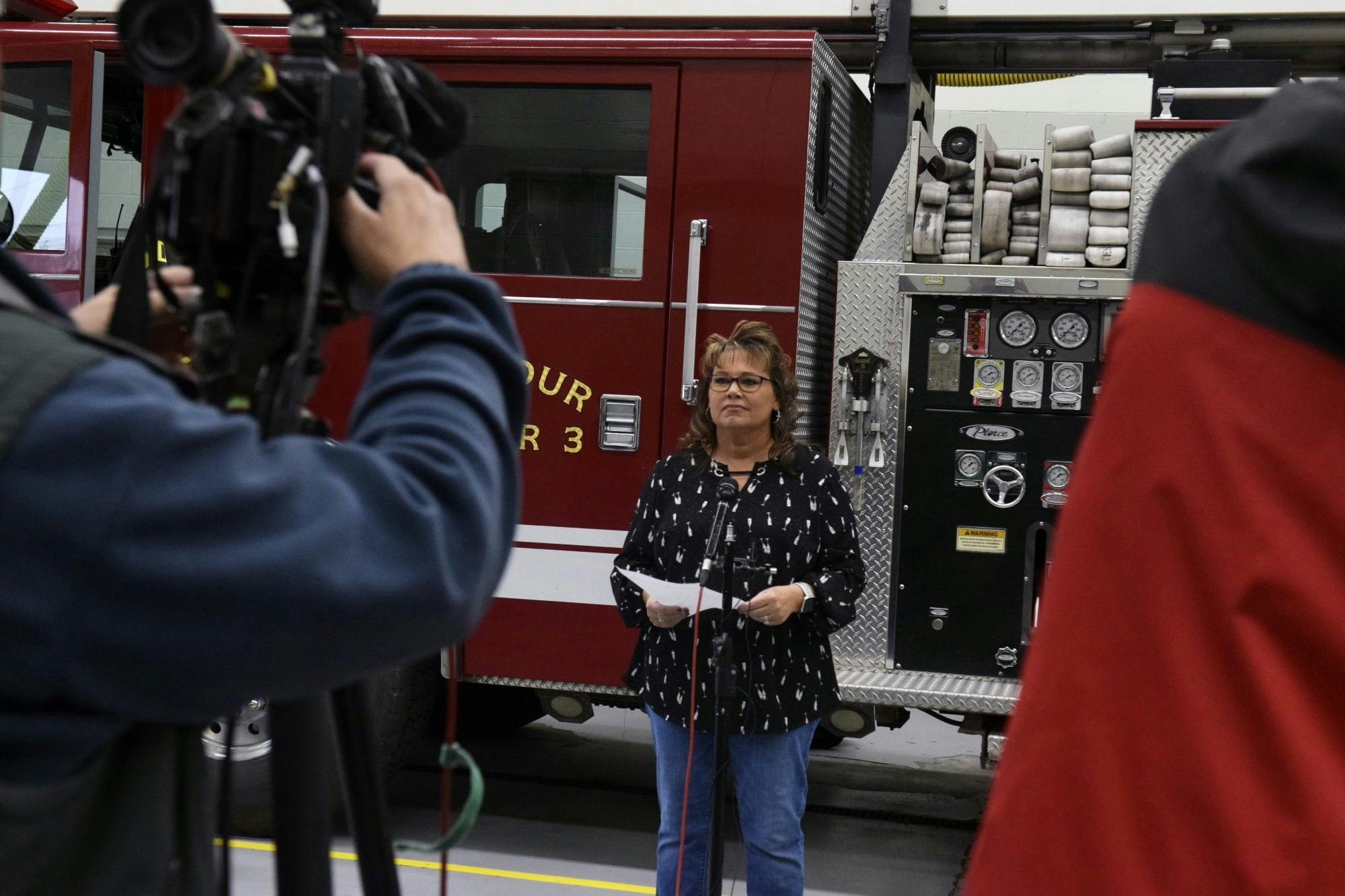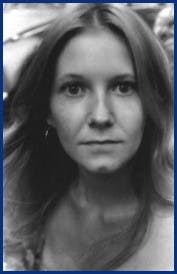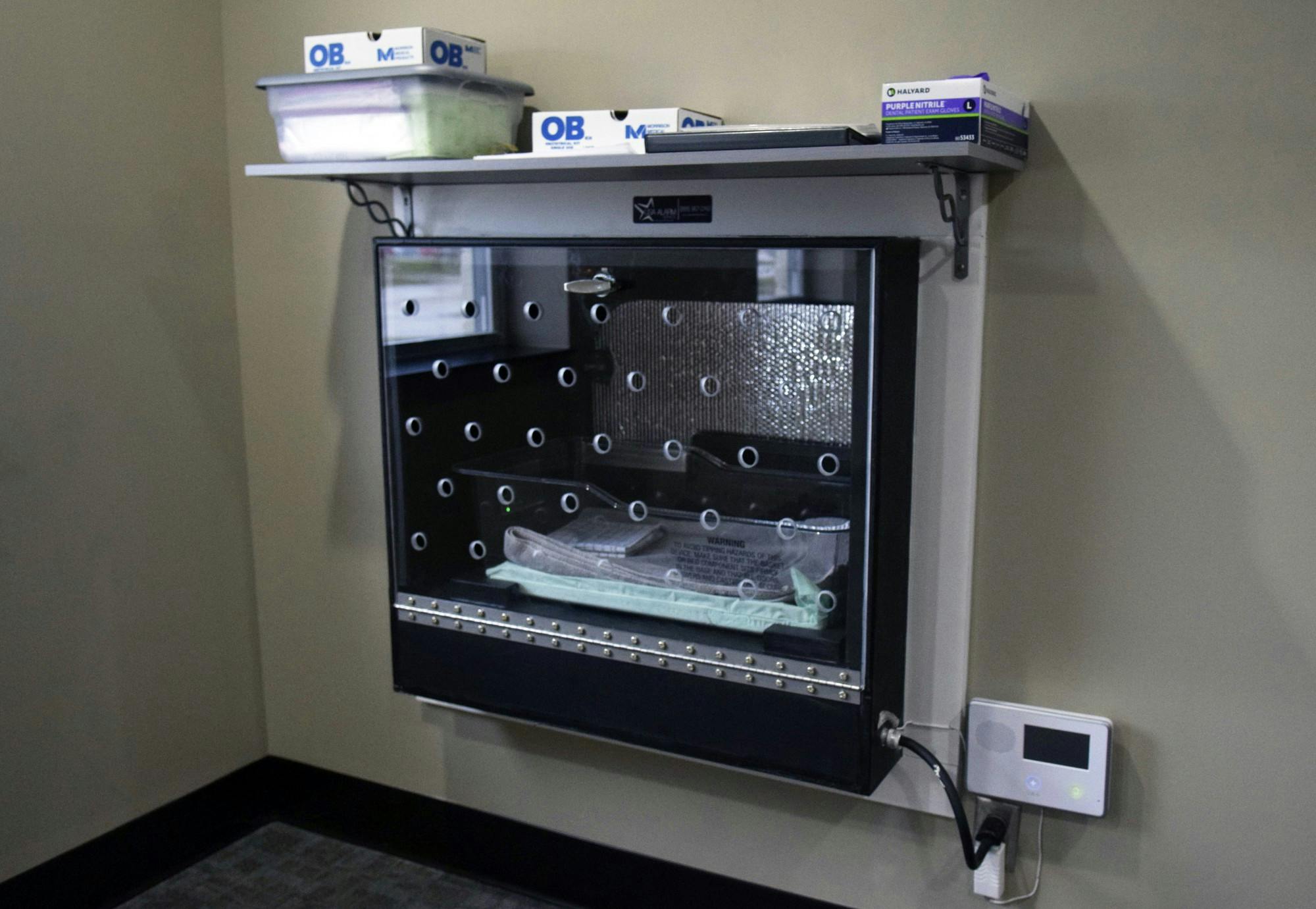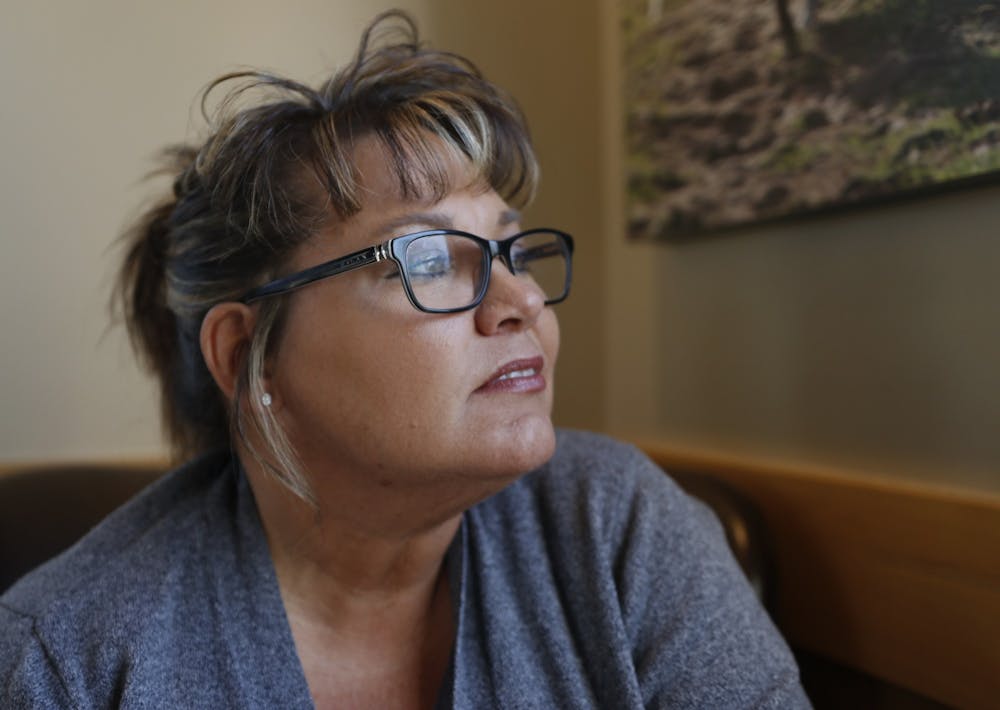It was a quiet afternoon at the fire station in Seymour, Indiana. There were no active calls. A load of laundry tumbled in the dryer. The firefighters on duty that Thursday in January waited for something to happen.
Outside the station wall, a new mother held her baby for the last time.
An alarm went off inside the fire station seconds after she walked away.
The firefighters had trained for this, but the reality of it jolted them. The alarm meant someone had made the unfathomable decision to surrender their baby, but she’d had the presence of mind to seek out a Safe Haven baby box, which offered a chance at safety for the baby and anonymity for the mother.
When the firefighters pulled open the door, they found a baby girl — maybe one hour old — wrapped in a cold, damp blanket. A firefighter pulled a warm towel out of the dryer.
Pretty soon, Monica Kelsey’s phone started to ring.
The next morning, Monica, founder of the Safe Haven Baby Box project, faced four news cameras and a small crowd of onlookers. Holding her speech in her hands, she applauded the bravery the mother showed in knowing what was best for her and her baby.
“All too often we hear stories of babies left in trash cans and dumpsters,” she said. “This parent loved their child enough to place this child safely and legally in a Safe Haven Baby Box."
Then she stepped away from the microphone, so it wouldn’t be all about her.
Monica is a 47-year-old former firefighter and medic and a mother of three. She knew people watching the event on TV would wonder how any mom could walk away from their baby. All Monica’s life had been spent considering that question, going back to the day she was born, when her own mother had walked out of the hospital and left her there. The decades since, especially these last few years, had helped her to understand. She had talked to so many birth mothers, including her own. She didn’t judge them anymore.
Back at the microphone, Seymour Fire Chief Brad Lucas said he was excited the box was successful. Hunter Wart, a high school student who raised $10,000 for the box to be installed, talked shakily about mowing lawns and collecting cans.

Monica watched from the side. She was glad her boxes worked. Before she installed the first baby boxes in the state, Indiana averaged two illegally abandoned babies each year.
There were no baby boxes in the United States until Monica began installing them in Indiana in 2016. Now there are 25. This baby was the fifth Indiana baby left or legally surrendered at a safe haven location. With the current system, after a baby is surrendered, they typically spend a little over a month in foster care before they are placed in their permanent home.
Since December, there have been three babies surrendered. Currently, 45 boxes are being installed in multiple states across the country, and a plan to install one at a Bloomington fire station is in the works.
Monica was happy the mother in Seymour could walk away knowing her baby was safe and she wouldn’t be pursued or arrested.
In 1973, Monica’s birth mother, Sandy, didn’t have that chance.
Two hours after Monica was born, Sandy climbed out of her hospital bed and vanished.
In 1973, no law protected mothers who couldn’t care for themselves and their babies. The first Safe Haven law allowing a person to anonymously give up an infant without fear of arrest was passed in Texas in 1999.
Sandy was 17 and unwed. Her family had pulled her out of school and kept her hidden. Her round belly had been their secret.
When she walked away from baby Monica, she faced abandonment charges. Police eventually caught up to her but decided not to prosecute. Monica doesn't know all the details, and Sandy isn't around to tell her them anymore.
Every year on April 19, Sandy baked a birthday cake. She iced it and decorated it and served it to her family.
She never told them who it was for. But Monica thinks they knew.
Monica grew up in a loving family that adopted her, but she wanted to look into someone’s face and feel something familiar looking back.
She was 37 when she went looking for her birth mother. She did some digging and got a phone number. A woman answered.
“Does April 19th, 1973, mean anything to you?” Monica asked. There was a pause.
And then the voice on the other end said: “I’ve been waiting for your call.”
Monica drove for three hours to meet Sandy that same day. Turned out, they looked nothing alike, but over the next three years, they met up about once a week. They ate fried Twinkies at the fair. They called each other “girlfriend.” They told stories from their separate lives. Sandy died in 2013.
“I get angry that I didn’t have more time with her,” Monica said. “There are still so many things I wanted to tell her.”
She had enough time with her birth mother to ask the hard questions. She learned she’d been conceived by rape. Knowing that sent her into a depression. How could she be a product of something so violent?
“I didn’t realize how unwanted I was,” she said.

Over time, Monica learned to accept what had happened to them both. She learned that to get out of a dark moment, you have to be able to see a new beginning.
Last month, Monica sat at her kitchen table in Woodburn, Indiana, where she lives with her husband, Joe. She scrolled through photos of herself speaking in front of hundreds of people, upright and stern and on-message. She has traveled the world telling her story.
“The way I look at my own life makes me want to educate people more,” said Monica, scrolling to the next photo. “I wanted people to know that my life had more value than the way it began.”
She scrolled by hundreds of faces until one made her stop. She stared into the screen, as if attempting to make the picture come to life.
It was a black-and-white photo of her birth mother at 17, her eyes looking directly at the camera. The glow from the laptop screen reflected on Monica’s face.
“She looks so beautiful in this one,” Monica said.
In 2013, three years after she met her birth mother, Monica took a trip to South Africa and saw one of the few baby safes in the world at a church.
It was a modern adaptation of an old solution to an ancient problem. Since before Moses was left beside the Nile in a basket, mothers have found ways to walk away from babies they couldn’t care for. Baby safes date back to at least 1198, when foundling wheels, similar to revolving doors, were installed in buildings and churches in Italy to stop women from drowning their babies in the Tiber River.
Monica had been advocating for the Safe Haven law, but she was sick over hearing about babies left on roadsides or in dumpsters. Even though the law protected women from prosecution if they left their baby in a safe place, it didn’t offer total secrecy. Some women were too afraid to go to a hospital, where there could be security cameras and questions. These mothers, Monica thought, should not have to look anyone in the eye and justify the hardest choice they’ve ever had to make.
On the flight home, Monica drew out a plan. She sketched the boxes on the back of a pamphlet. Security, alarms and temperature regulation were some of the key features, but an 800 number was at the top. She wanted to make sure the mothers had someone to call.
She knew they’d be difficult and expensive to build and install. She suspected they’d be controversial.

As she worked on her plan while fundraising for the project, a baby girl was found dead under a tree branch in Eagle Creek Park in Indianapolis in 2014, and in 2016, a baby was found sunburned but alive in a family’s backyard in Lake County with her placenta still attached.
Monica wanted a better way.
Her fight to install the Safe Haven Baby Boxes began in her hometown, where her husband is mayor.
There were no laws saying she could or couldn’t install the boxes. The boxes themselves are constructed in a multi-stage process, with one company creating the shell, another installing alarms and a third working on the wiring. After the first box was installed at the Woodburn Fire Department in 2016, Monica received a letter from the Indiana Department of Child Services signed by then-director Mary Beth Bonaventura.
“I fully understand and am supportive of your goal to protect infants who otherwise might be abandoned,” read the letter. “However, I have very serious concerns for the safety of any child placed in a baby box.”
Critics warned that the boxes could malfunction and noted that women in Indiana already had a safe, legal way to give up their babies.
Michael Morrisey, who ran a New England Safe Haven nonprofit, got so carried away in his insistence the baby boxes were potentially dangerous and a “scam” that his dispute with Monica ended up in court multiple times after she sued him for defamation. Judges awarded Monica $40,000 in damages and ordered Morrisey and his wife not to contact her. Morrisey’s organization had its nonprofit status involuntarily revoked in 2012.
Monica thought that when people started to see boxes saving babies, skeptics would change their minds.
One of the first boxes was installed in 2017 at the Cool Springs Volunteer Fire Department in Michigan City, Indiana. Firefighter Chuck Kohler came into the station one day in 2018 and heard a baby crying.
Kohler is a father of four and a foster parent. His dad instincts kicked in.
“I knew I had to do whatever I could to make sure that baby was safe,” he said.
Kohler has since reunited with the baby he found and brought to medical care that day. He said he wouldn't trust the boxes if they didn’t work.
“It’s not just about throwing your baby in and leaving,” he said. “These decisions are thought through. These mothers have the chance to call the number and talk to someone first. It’s about helping the mother and the baby.”
Even some advocates for the Safe Haven law worried the boxes made abandoning babies too easy, but Monica stresses that the boxes are a last resort.
Monica says she puts an 800 number on the boxes for a reason. When the number is called, one of two licensed counselors picks up. If they’re both busy, the call goes to Monica. She wants the mothers to have a chance to find help.
Because of those conversations, some of the surrenders happen in person with Monica or a counselor, not through the boxes.
“The idea is to get the baby in the hands of someone who can take care of them,” she said.
Last year, Monica received an email from a birth mother who surrendered her baby and wanted to share her story.
The woman wrote that she gave birth alone at home and spent 36 hours snuggling her baby, contemplating the rest of their lives together or apart. She named her Mila and wanted to keep her, but in all of the scenarios she thought through, she couldn't make it work.
“She deserved the world and so much more,” she wrote. “I could have went to a hospital, police, or fire station, but being 100% anonymous was the only option for me. There are questions you have to answer at those locations that could have put myself or my baby in danger. And anyone knowing my identity could be deadly for either of us. Those things I was not prepared to do.
“After reading Monica's story and the choice her biological mother made and the strength she has now gave me the strength to make the biggest decision of my life and Mila's life."
She said her "I love you"s and "goodbye"s, and she placed Mila in the box along with a two-page letter that she hopes her daughter will read someday.
Baby Mila is now with the people who plan to adopt her, Monica said.
Babies surrendered in Monica’s boxes across Indiana are turning 2, 3, 4 years old. Babies directly surrendered to medical personnel and firefighters at other locations under the Safe Haven law are reaching adulthood. One in Monroe County has, in his two years, touched the ocean, eaten beignets in New Orleans and gotten stamps on his passport.
His adoptive mom, Jennifer, thinks about her son’s birth mother constantly. On her first Mother’s Day with her son, she thought she’d be celebrating. Instead, she felt sadness for her son’s birth mother.
Where is she now? Is this day hard for her? Does she regret her decision? Jennifer doesn’t know, but she prays for her. She prays for herself and her son’s birth mother; that they would be strong enough to handle the pain and the love.
Monica’s youngest child moved out six months ago at 20 years old, making Monica and Joe empty nesters.
Late one night last year, Monica got a phone call from a woman who said she had a new baby and was scared. Monica and Joe helped her all they could, giving her gas gift cards, food and time. After the woman had her baby, she tried to make it work, but things got worse.
After one especially hard night, she called Monica. After fifteen months of trying and failing to make it work, she needed someone to take the baby.
Monica had raised her kids. She was 47 years old. She had done enough. She ran through everything in her head: her work, her family and her home. Then she thought about the baby and the mother, whom she had already gotten to know and had helped through turbulent times.
She said yes.
Then she turned to Joe. “How much do you love me?” Monica asked. “I just did something and I don’t know how you’re going to feel.”
Monica and Joe passed a drug screening and went to court. At first, they were supposed to have the baby for 60 days. Now, they are approaching their sixth month with her.
They call her Miss K. She is a year-and-a-half old. She’s clumsy, conversant in sign language and fluent in gibberish.
“She’s a girly girl,” Monica said while examining Miss K’s sparkly red fingernail polish. Monica had painted them the night before in a shade called Make My Day. Miss K took off her socks and showed off her glossy nails. Monica blew on her toes and Miss K giggled.
Monica doesn’t know if Miss K’s mother will be able to earn her back. She hopes so. If the time comes and Monica is asked to adopt, she isn’t sure she can do it. She wants to.
What would her speeches mean if she couldn’t offer the love she speaks of? But she wants Miss K to have the whole world, and it’s hard for Monica to believe she can give her enough because she's always on the road with her work.
She isn’t the type to dwell on decisions -- she will make them when she has to. But she has learned that when people are tested, they do all kinds of things they never imagined.
They pursue costly fertility treatments. They become parents alone. They pull money out of their retirement savings to take in their grandbabies. They give birth in their cars, in closets, in alleys and in bathtubs. They leave their babies at hospitals, churches and in fancy boxes in fire station walls. Monica doesn’t judge anybody, not even herself.
No one knows what they can handle until the moment arrives.
Monica watches Miss K gaze up at the TV, where the Jim Carrey version of “How the Grinch Stole Christmas” plays practically on a loop.
Miss K watches as the baby Grinch, cold and alone in a tattered baby carriage and drifting through the night, settles at the home of two strangers who will soon take him in and raise him as their own.
For information on Safe Haven baby boxes 888-742-2133. If you are pregnant and in crisis and would like to speak to a counselor call 866-99BABY1, 24 hours a day, seven days a week.




